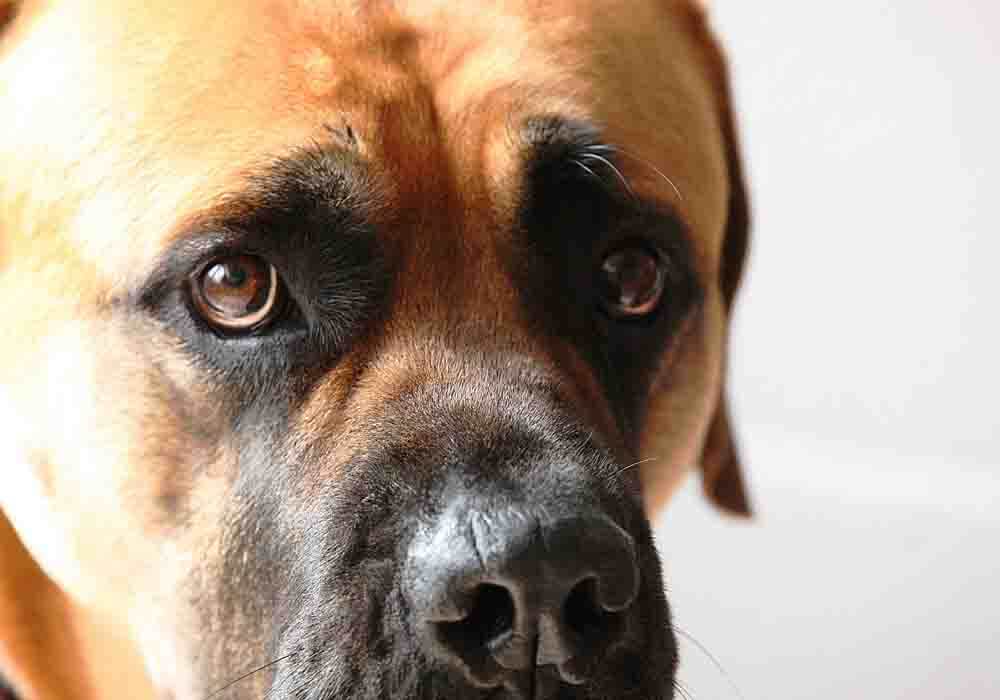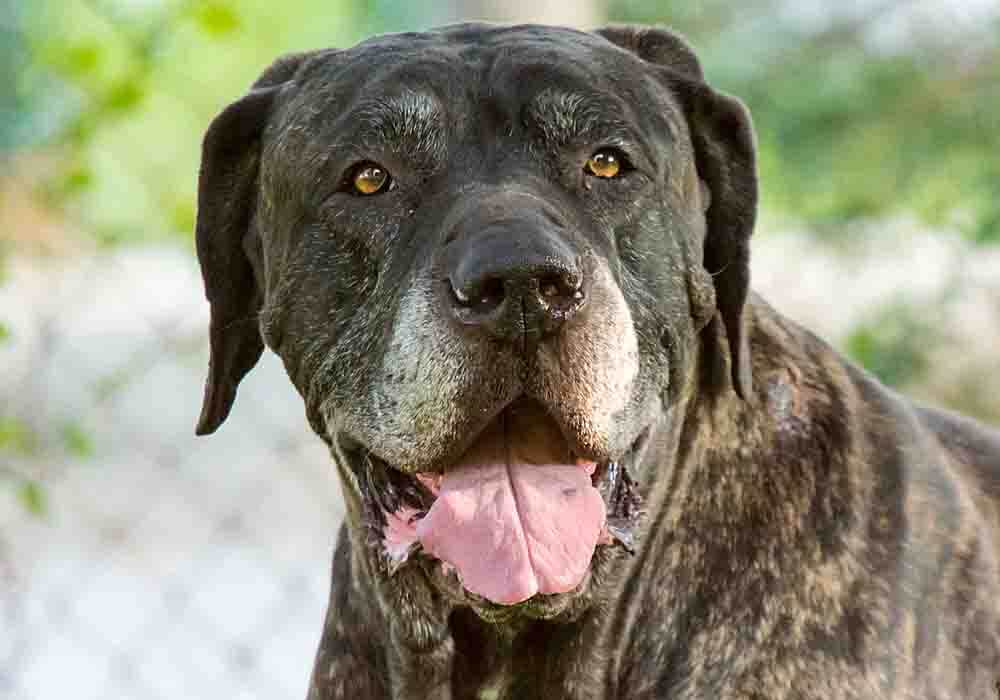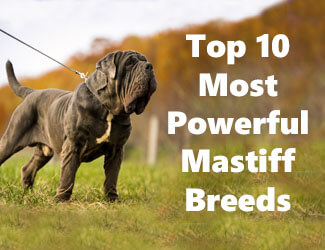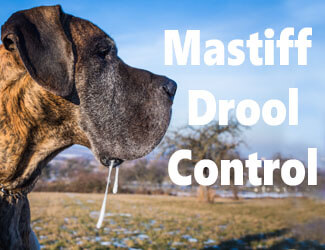Why Is My Mastiff
So Scared Of Everything?
by Ken Alden
So why is my mastiff so scared of everything when it's such a big dog!
We all want our dogs to be as calm and composed as possible, and fortunately, mastiffs are one of the most confident dog breeds around. But what happens when your mastiff's confidence is threatened, and they begin to show signs of fear?
Why Is My Mastiff So Scared Of Everything?
Reasons your mastiff is so scared may include early trauma during their puppyhood or a more significant traumatic event as an adult. Pain is often confused as fear, as many dogs lash out in self-defense. Lastly, your mastiff may be experiencing fear stages, which is normal for all dogs.
This article will explain everything you should know about your mastiff's anxiety, including information on their fear stages. We’ll also cover some ways in which you can help them.
Pro-tip: Ever try lifting a Mastiff? Their weight can hurt not only your back but their joints when they hop down from cars, sofas or even your bed. To protect your back and theirs check out the best Mastiff ramps on Amazon.com now.

What Causes Fear In Mastiffs?
Mastiffs are very courageous dogs, so it’s a cause of worry to see your once brave pet become scared. Unfortunately, there are no easy answers to helping your mastiff recover from this fear. However, you can adopt several steps to enable it to gain courage again.
Factors that cause fear in mastiffs include inadequate socialization, pain, traumatic experiences, and genetic predisposition. Luckily, proper training can aid in socialization, and a vet visit should help with any discomfort. However, it becomes more complicated when looking at trauma and genetics.
Fearful behavior is strange and unpleasant to dog owners, and the last thing you want to see is your sweet companion being startled by every little trigger. However, it is quite common in dogs of all breeds to show signs of fear. Still, dogs do not develop these tendencies without reason.
Let’s go over some of the most popular reasons why a mastiff may suddenly become scared.
Inadequate Socialization
Most dog experts suggest that a lack of proper socialization can cause a dog to develop anxiety disorders. This is why vets often advise positive exposure to other animals, people, and environmental factors during their critical fear period (more on this later).
From a young age, dogs need to experience a variety of pleasant interactions to help them get used to the unexpected. Mastiffs may grow to become wary of new or unusual things if they are not properly introduced to the world from their puppyhood stage.
Pain
Just like humans, dogs react to pain in different ways. Some dogs may act scared and shake when exposed to certain levels of pain, where others may lay still for hours on end.
Mastiffs usually act out and are visibly shaken if they feel pain in their neck, back, or abdomen, which may also limit them from walking. It’s not uncommon to see dogs lash out when touched for fear of experiencing more pain.
So, next time you notice your mastiff visibly terrified, it could be that they’re actually trying to alert you to an injury.
Pro-tip: Mastiff anxiety, aggression, destructive chewing, jumping up, fearfulness, and other behaviors can be controlled with the right training program.
Here’s a great course that
addresses these issues along with many other dog training basics: Check it out now!
Traumatic Experiences
Another theory is that your furry friend may have had some traumatic experiences in the past. For some dogs, it takes a single traumatic event for them to develop lifelong fear responses.
For instance, your mastiff may develop a fear of loud noise because of an incident with firecrackers on the Fourth of July. In this kind of situation, you may see their fear triggered at the sound of anything from a car door slamming to thunder.
Genetic Predisposition
Some dogs may also become nervous because of their genetic predisposition. This could be why your mastiff will sometimes pick up the habit of shyness or fearfulness from a young age.
In addition, puppies are very likely to become fearful if they are born to nervous mothers.
Mastiff Fear Stages
When asking yourself why is my mastiff so scared of everything there's one critical aspect to consider when learning about your mastiff's fear is its different stages. Fear stages are expected for every dog, especially during their puppyhood days. This period leaves puppies more sensitive and aware of the world around them.
Unfortunately, no amount of socialization can stop your mastiff from passing through this period. However, there are some ways in which you can help make this phase a little easier.
Here's a brief overview of the different stages of fear.
Fear Imprint Stage (8-10 Weeks)
If you understand a dog's development, you'll know that this is a crucial period in their development. It is the stage where puppies develop social skills and understand the world around them.
Subjecting your mastiff to physical or psychological trauma during this time can make them susceptible to developing a lifelong avoidance response. This is why it’s not recommended to take puppies from their mothers at such a young age.
Pro-tip: Mastiff's (and their owners) love dog crates…and for good reasons. Crates keep dogs from mischief while you're away, are perfect for house training, for traveling by car, and provide the dog a place to de-stress. Check out the best Mastiff crates on Amazon.com now.
Adolescent Fear Period (12 Weeks - 6 Months)
At this stage, puppies have become autonomous, but they're learning about the world.
Painful experiences like teething can cause them to become scared, and you may begin to see noticeable changes in your puppy as early as 12 weeks.
The best way to help your puppy through teething is to provide them with plenty of chew toys (nothing too hard) and to never yell or punish your puppy for chewing up something they shouldn’t.
Flight Instinct Fear Period (6-9 Months)
This is a very critical stage in every dog's life. Unfortunately, mastiffs generally find this period challenging, and that's why you may suddenly find them scared of strangers or other dogs.
Experts often refer to this phase as "teenage flakiness." You may notice your dog becoming afraid at the silliest of things.
During this stage, it is often recommended to not overexpose them to new people or places.
Adult Fear Period (12-18 Months)
Dogs generally continue to experience the fear period even after the one-year mark. But, again, this is because they are still growing; most people relate this fear period to the surge in growth and development that occurs at this point.
The key thing to remember is that all of this is normal and that your puppy should outgrow the behavior.
Helping Your Mastiff Overcome Its Fear
Unfortunately, helping your mastiff overcome its fear is not as easy as you think, and you may need some level of trial and error to determine the best for your dog.
But, if you are ready for it, here are three tips that can help.
Don’t Encourage Their Fear
People often encourage their dog's fears without knowing it, as it's natural to want to comfort your mastiff when you notice that it's in distress. Unfortunately, some dogs see this as a reward for their fearful behavior. This can “teach” them to continue behaving in a certain way to get attention and treats.
Instead of comforting your mastiff, we recommend remaining as calm as possible and not giving treats without them earning it. It is better to try and distract your mastiff and give treats when they perform and trick instead.
Expose Your Mastiff to Their Fear in a Controlled Environment
Your pet's fear may be a result of certain noise or other familiar stimuli. If this is the case, you can help it overcome the fear by desensitizing it.
One of the best ways to do this is by exposing it to the stimulus in a controlled setting.
For example, if your mastiff is afraid of loud noises, such as thunder, try playing thunder sounds on your phone quietly. Turn the volume up gradually, and always keep an eye on how your dog is reacting.
Over time, your mastiff should become more used to the sound, and you should be able to turn the volume right up without them reacting at all.
Note: Experts warn that you should work with a vet or a trained expert when attempting this kind of desensitization. Doing it without professional guidance may make matters worse.
Visit a Vet
Nothing beats having an expert look at your dog's situation. Make notes of your mastiff’s reactions, and try to get a video if possible to show your vet how they respond to certain stimuli.
Your vet will be able to decide whether your dog needs physical therapy or medication to overcome its fears. They may even have a few simple tricks to try at home.
If you have a pet sitter, ensure to communicate your dog's specific needs to them.
Why Is My Mastiff So Scared Of Everything...Final Thoughts
Mastiffs can exhibit many different habits, but fear is one of the oldest and most common. Before taking any action, it's essential to carefully monitor your mastiff to know what may be wrong. Remember, you could be seeing a sign of pain rather than a fear response.
If your mastiff is still a puppy, chances are it is going through the normal fear stages all dogs experience. However, if your dog is an adult and suddenly developing fearful responses, you may need to visit your vet for a check-up.
Return to the top of this Why Is My Mastiff So Scared Of Everything page

About the Author...
Ken Alden, a dedicated Mastiff owner for over eight years, is acclaimed for his expertise in care, grooming, and training. Read more About Me and my dog Shadow.
- Mastiff Guide Home ›
- Mastiff Dog Info ›
- Why Is My Mastiff So Scared Of Everything?









